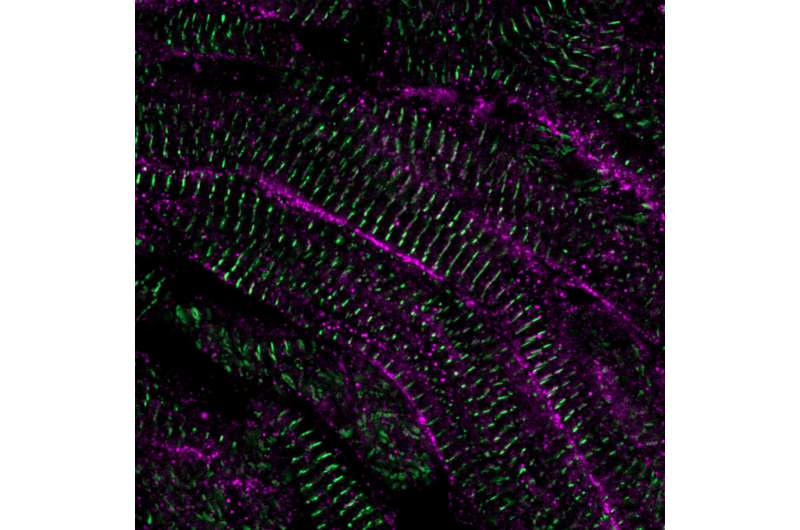This article has been reviewed according to Science X's editorial process and policies. Editors have highlighted the following attributes while ensuring the content's credibility:
fact-checked
peer-reviewed publication
trusted source
proofread
How to repair a damaged heart: Key mechanism behind heart regeneration in zebrafish revealed

Cardiovascular diseases, such as heart attacks, are a leading cause of death worldwide resulting from a limited self-healing power of the heart. Unlike humans, zebrafish have the remarkable capacity to recover from cardiac damage. Researchers from the group of Jeroen Bakkers (Hubrecht Institute) have used the zebrafish to shed light on their regenerative success. They discovered a new mechanism that functions as a switch to push the heart muscle cells to mature in the regeneration process. Importantly, this mechanism was evolutionary conserved as it had a very similar effect on mouse and human heart muscle cells.
The results of the study, published in Science on May 18, show that examining the natural heart regeneration process in zebrafish and applying these discoveries to human heart muscle cells could contribute to the development of new therapies against cardiovascular diseases.
It is estimated that 18 million people die from cardiovascular diseases every year. Many of these deaths are related to heart attacks. In such an event, a blood clot prevents the supply of nutrients and oxygen to parts of the heart. As a result, the heart muscle cells in the obstructed part of the heart die, which eventually leads to heart failure. Although therapies exist that manage the symptoms, there is no treatment that is able to replace the lost tissue with functional, mature heart muscle cells and thereby cure the patients.
Zebrafish as a role model
Unlike humans, some species like zebrafish can regenerate their hearts. Within 90 days after damage, they fully restore their cardiac function. The surviving heart muscle cells are able to divide and produce more cells. This unique feature provides zebrafish hearts with a source of new tissue to replace the lost heart muscle cells. Previous studies successfully identified factors that could stimulate heart muscle cells to divide. Nevertheless, what happens to the newly formed heart muscle cells afterwards had not been studied before.
Phong Nguyen, first author of the study, explains, "It is unclear how these cells stop dividing and mature enough so that can they contribute to normal heart function. We were puzzled by the fact that in zebrafish hearts, the newly formed tissue naturally matured and integrated into the existing heart tissue without any problems."
LRRC10 drives maturation
To study maturation of the newly formed tissue in detail, the researchers developed a technique for which thick slices of injured zebrafish hearts were cultured outside the body. This allowed them to perform live imaging on the movement of calcium in heart muscle cells. The regulation of calcium moving in and out of heart muscle cells is important for controlling heart contractions and can predict the maturity of the cell. The team found that after the heart muscle cells divide, calcium movements changed over time.
"The calcium movement in the newly divided cell was initially very similar to embryonic heart muscle cells, but over time the heart muscle cells assumed a mature type of calcium movement. We found that the cardiac dyad, a structure that helped to move calcium within the heart muscle cell, and specifically one of its components, LRRC10, was crucial in deciding whether heart muscle cells divide or progress through maturation. Heart muscle cells that lack LRRC10 continued to divide and remained immature," says Nguyen.
From fish to human
After Nguyen and his colleagues established the importance of LRRC10 in stopping cell division and initiating maturation of zebrafish heart muscle cells, they moved on to test if their findings could be translated to mammals. To this end, they induced the expression of LRRC10 in mouse and lab-grown human heart muscle cells.
Strikingly, LRRC10 changed the calcium handling, reduced cell division and increased the maturation of these cells in a similar manner as observed in zebrafish hearts. Nguyen says, "It was exciting to see that the lessons learned from the zebrafish were translatable as this opens new possibilities for the use of LRRC10 in the context of new therapies for patients."
Clinical impact
The results of the study, published in Science, show that LRRC10 has the potential to drive the maturation of heart muscle cells further through the control of their calcium handling. This could help scientists who are trying to solve the lack of regenerative capacity of the mammalian heart by transplanting lab-grown heart muscle cells into the damaged heart. Although this potential therapy is promising, results showed that these lab-grown cells are still immature and cannot communicate properly with the rest of the heart, leading to abnormal contractions called arrhythmias.
"Although more research is needed to precisely define how mature these lab-grown heart muscle cells are when treated with LRRC10, it is possible that the increase in maturation will improve their integration after transplantation," says Jeroen Bakkers, last author of the study.
"Additionally, current models for cardiac diseases are frequently based on immature lab-grown heart muscle cells. 90% of promising drug candidates found in the lab fail to make it to the clinic and the immaturity of these cells could be one contributing factor for this low success rate. Our results indicate LRRC10 could improve the relevance of these models as well."
LRRC10 could thus have an important contribution to generate lab-grown heart muscle cells that more accurately represent a typical adult human heart, therefore improving the chances of developing successful new treatments against cardiovascular diseases.
More information: Phong D. Nguyen et al, Interplay between calcium and sarcomeres directs cardiomyocyte maturation during regeneration, Science (2023). DOI: 10.1126/science.abo6718. www.science.org/doi/10.1126/science.abo6718




















